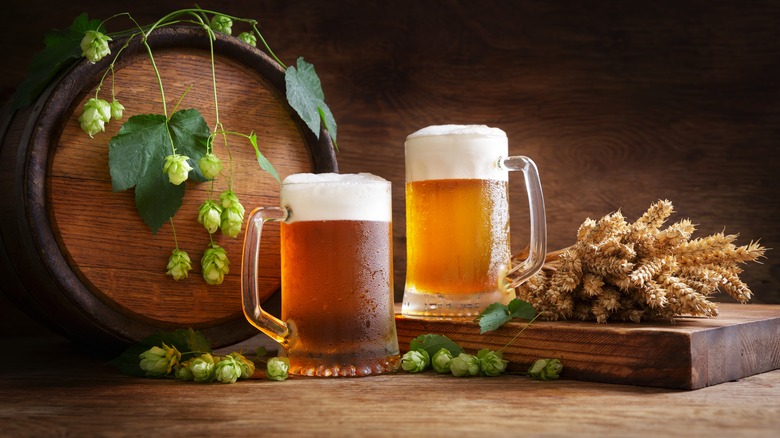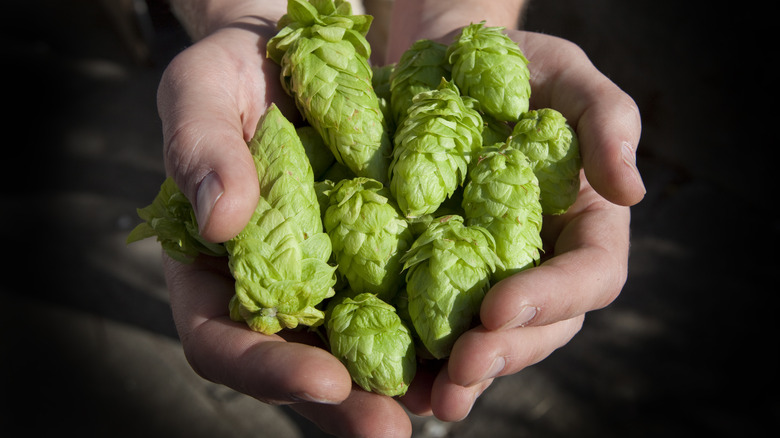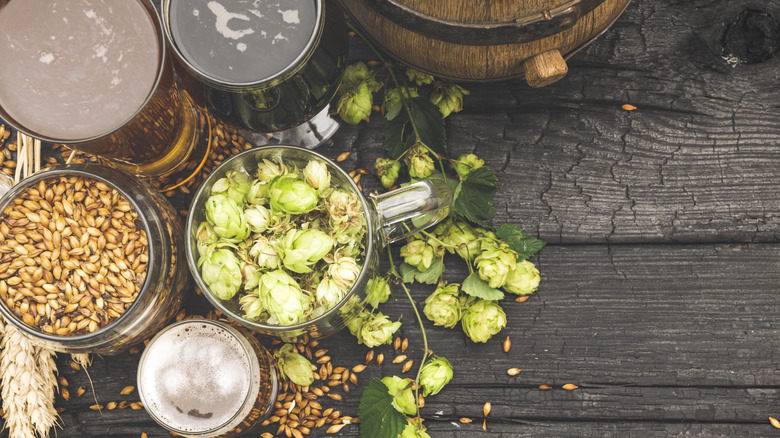What Do Hops Actually Do For Beer?
Think of the perfect pour of your favorite beer — ice cold, fragrant, and the perfect amount of foam on top. You can almost taste that crisp first sip, right? Believe it or not, the freshness and fragrance of a beer are largely thanks to this single ingredient. With the rising popularity of big, hoppy Indian Pale Ales (IPAs), most brewhounds associate hops with the bitter taste and higher alcohol content of these ales, but really, hops play a crucial role in lagers, stouts, porters, hefeweizens, and more.
While hops may seem magical, they're actually nothing more than the female portion of the flowering cone plant, Humulus lupulus. Inside these cones is a sticky, yellow resin known as lupulin, which contains the oils and acids that eventually create the complex flavor profiles of each beer. The basic recipe for beer is pretty simple, containing only malt, water, yeast, and hops.
However, the balance and strength of these ingredients create an endless variety of acidity, bitterness, color, and flavor. Typically, brewers add hops to the mixture in one of the three stages of the boiling phase. Adding hops at the beginning of boiling adds bitterness; adding it in the middle creates flavor; lastly, adding it at the end stage creates aroma. For an extra punch of flavor, brewers may add even more during the fermentation process, a practice known as dry hopping.
Become an acid expert
Within hops, there are two main types of acids — alphas and betas. Alphas are responsible for that classic hoppy taste you'll find in IPAs and Double IPAs and come to life during the boiling process. Found in the resin of the flowering cones, alpha acids transform into iso-alpha acids via a chemical reaction called isomerization. The result is that lip-smacking, tongue-tingling bitterness that heightens the flavor profile of the beer. An added bonus to alpha acids is that they also contain antimicrobial properties, extending the shelf stability of the brew – and yes, unopened cans of beer do expire.
Meanwhile, beta acids are responsible for the plant's other areas of expertise — flavor and aroma. While betas are also found in hop resin, beta acids oxidize and release compounds like geraniol, linalool, and citronellol. These compounds can give the beer a fruity and even citrusy aroma and taste on top of the malt's natural flavors. Beta acids also have the ability to change a beer's profile as it ages; the more betas present, the less the bitterness of the beer will diminish over time. Ultimately, the ratio of alpha and beta acids in hops will determine the bitterness, aroma, and flavor of the batch.
All hops are not created equal
As you can imagine, there are quite a few varieties of hops that are grown all across the globe in different climates and circumstances, resulting in a spectrum of acidic profiles and purposes. Among the most popular hops that brewers use are Cascade and Amarillo hops, both of which originated in the United States (per Beer Analytics).
Cascade hops are considered a dual purpose, meaning that they can be used for both bittering and aromatic functions. This also means that Cascade hops have a fairly high volume of alpha and beta acids in order to accomplish both purposes. Typically, you'll find these hops in brews like IPAs, American-style Pale Ales (APAs), and other American Ales, adding a floral aroma with some citrus tasting notes on the back end of the sip.
Likewise, Amarillo hops are a fairly versatile variety, which is why they are a go-to option for home brewers and commercial brewers alike. While Amarillo hops can be used for bittering, its primary purpose is for aroma. The beta acids in these hops add a unique blend of citrusy flavors, even resembling tropical fruits like pineapple and grapefruit. You'll likely find this variation in beers like APAs, IPAs, and Double IPAs.
Of course, these are just two of a very long list of hops that have their own characteristics and balances. The best way to discover them all is to crack open a tab and taste their nuances for yourself.
Pröst!



